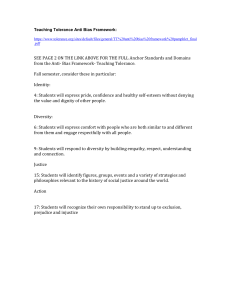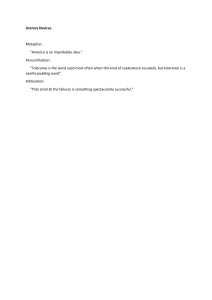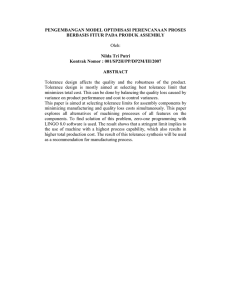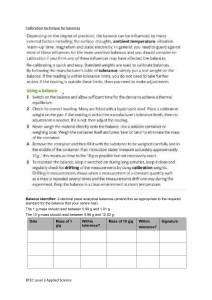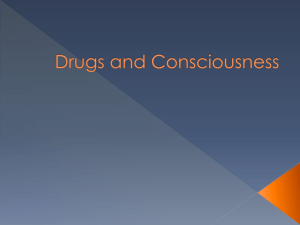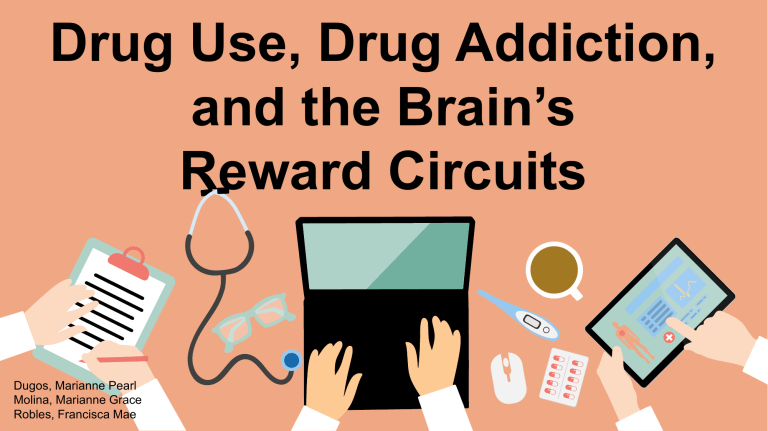
Drug Use, Drug Addiction, and the Brain’s Reward Circuits Dugos, Marianne Pearl Molina, Marianne Grace Robles, Francisca Mae Chapter Overview 01 Basic Principles of Drug Action 02 Role of Learning in Drug Tolerance 03 Five Commonly Used Drugs 04 Comparing the Health Hazards of Commonly Used Drugs 05 Early Biopsychological Research on Addiction 06 Current Approaches to the Mechanisms of Addiction Basic Principle s of Drug Action Drug Administration, Absorption, and Penetration of the CNS Oral ingestion 01 2 main advantages: ease and safe Injection 02 03 Effects of injected drugs are strong, fast, and predictable Drug injections typically done through: (SC) subcutaneously – into fatty tissue just beneath the skin (IM) intramuscularly – into large muscles (IV) intravenously – directly into veins at points where they run just beneath the skin Inhilation Difficult to regulate the dose of inhaled drugs 04 Absorption through mucous membranes Nose, mouth, and rectum Drug Action, Metabolism, and Elimination Drug Penetration of the CNS Blood-brain barrier (protective filter) makes it difficult for dangerous bloodborne chemicals to get into the extracellular space of CNS neurons and glia. Mechanisms of Drug Action Psychoactive drugs influence the nervous system in many ways Act diffusely on neural membranes throughout the CNS Others act in a more specific way: By binding to particular synaptic receptors By influencing the synthesis Transport Release Deactivation of particular neurotransmitters Influencing the chain of chemical reactions elicited in postsynaptic neurons by the activation of their receptors Drug Metabolism and Elimination The actions of most drugs are terminated by enzymes synthesized by the liver. Drug metabolism – conversion of active drugs to nonactive forms. Drug Tolerance A state of decreased sensitivity to a drug that develops as a result of exposure to it Demonstrated in 2 ways: By showing that a given dose of drug has less effect than it had before exposure By showing that it takes more of the drug to produce the same effect Drug tolerance is a shift in the does-response curve to the right Drug Tolerance, Drug Withdrawal Effects, and Physical Three important points to remember about the specificity of drug Dependence tolerance: Cross tolerance – one drug can produce tolerance to other drugs that act by the same mechanism Drug tolerance often develops to some effects of a drug but not to others. Drug sensitization – increasing sensitivity to a drug. Drug tolerance is not a unitary phenomenon; that is, there is no single mechanism that underlies all examples of it. Two categories of changes underlie drug tolerance: Metabolic – drug tolerance that results from changes that reduce the amount of the drug getting to its sites of action Functional – dug tolerance that results from changes that reduce the reactivity of the sites of action to the drug. Drug Addiction: What is it? Drug-addicted individuals are habitual drug users, but not all drug users are drug-addicted individuals. Drug-addicted individuals – habitual drug users who continue to use a drug despite its adverse effects on their health and social life, and despite their repeated efforts to stop it. Sometimes take drugs to prevent or alleviate their withdrawal symptoms Role of Learning in Drug Tolerance An important line of psychopharmacologic study research has shown that learning plays a major role in drug tolerance. Research on the role of drug tolerance has focused on two phenomena: Contingent Drug Tolerance Conditioned Drug Tolerance Contingent Drug Tolerance Contingent drug tolerance refers to demonstrations that tolerance develops only to drug effects that are actually experienced. This Drug tolerance is contingent or dependent on the repeated expression of the drug effect rather than on mere exposure to the drug. Before-and-after design - In before-and-after experiments, two groups of subjects receive the same series of drug injections and the same series of repeated tests, but the subjects in one group receive the drug before each test of the series and those in the other group receive the drug after each test of the series. At the end of the experiment, all subjects receive the same dose of the drug followed by a final test so that the degree to which the drug disrupts test performance in the two groups can be compared. Conditioned Drug Tolerance Conditioned Compensatory Responses Studies of conditioned drug tolerance focus on the situations in which drugs are taken. A conditioned compensatory response is an automatic response that the body and mind experience that is opposite of the effects of alcohol or drugs. Reinforcement exercises Conditioned drug tolerance refers to demonstrations that tolerance effects are maximally expressed only when a drug is administered in the same situation in which it has previously been administered. Most demonstrations of conditioned drug tolerance have employed: Exteroceptive . stimuli - (external, public stimuli, such as the drugadministration environment) as the conditional stimuli. Interoceptive stimuli - (internal, private stimuli) are just as effective in this role. Five Commonl y Used Drugs Tobacco Nicotine – major psychoactive ingredient of tobacco—and some 4,000 other chemicals collectively referred to as tar, are absorbed through the lungs. Drug craving – effective state in which there is a strong desire for the drug. Habitual smokers who stop smoking experience a variety of withdrawal effects: Depression Anxiety Restlessness Irritability Constipation Difficulties in sleeping and concentrating Smoker’s Characterized by chest syndrome pain, labored breathing, wheezing, coughing, and heightened susceptibility to infections of the respiratory tract. Buerger’s Disease The blood vessels especially those supplying the legs, become constricted. Teratogen An agent that can disturb the normal development of the fetus. Alcohol Is a depressant (reduce arousal and stimulation) because at moderateto-high doses it depresses neural firing; however, at low doses, it can stimulate neural firing and facilitate social interaction Moderate doses can cause the alcohol drinker to lose control which can lead to socially unacceptable actions High doses result in unconsciousness; and if blood levels reach 0.5 percent, there is a risk of death from respiratory depression Hangover – withdrawal from alcohol Four phases: After 6-8 hours – anxiety, tremor, nausea, and tachycardia (rapid heartbeat) After 10-30 hours – hyperactivity, insomnia, and hallucinations Between 12 and 48 hours – convulsive activity After 3-5 days and lasts after a week – delirium tremens (DTs) which are characterized by disturbing hallucinations, bizarre delusions, disorientation, agitation, confusion, hyperthermia (high body temperature), and tachycardia. Korsakoff’s syndrome A neuropsychological disorder characterized by memory loss, sensory and motor dysfunction, and, in its advanced stages, severe dementia Cirrhosis Extensive scarring of the liver Fetal Alcohol Syndrome (FAS) Condition that the offspring of mothers who consume substantial quantities of alcohol during pregnancy Mariju ana Marijuana is the name commonly given to the dried flower buds of Cannabis—the common hemp plant if which there are three species: Cannabis sativa Cannabis indica Cannabis ruderalis THC (delta-9-tetrahydrocannabinoids) – a constituent in which the psychoactive effects of marijuana are largely attributable. At low, usual “social” doses, the intoxicated individual may experience an increased sense of well-being. High does impair psychological functioning Tolerance to marijuana develops during periods of sustained use No damage that can reasonably be attributed to marijuana use has been found in the brains of living or deceased marijuana users. However, three lines of indirect correlational evidence have a bearing on the question: Brain-imaging studies have found that hippocampal volumes tend to be slightly reduced in some heavy marijuana users. However, such findings might be the result of preexisting differences between users and nonusers. Heavy marijuana users tend to have memory problems. However, because it is not clear whether the memory deficits persist after the cessation of marijuana use, it is not clear if they are indicative of persistent brain damage. Heavy marijuana users are slightly more likely to be diagnosed with schizophrenia—especially if they began using marijuana during adolescence. Marijuana may actually have neuroprotective effects. Therapeutic effect of THC Suppress nausea and vomiting in cancer patients Stimulate the appetite of patients with AIDS Block seizures Dilate the bronchioles of asthmatics Decrease severity of glaucoma Reduce anxiety Cocaine and Other Stimulants Stimulants Drugs whose primary effect is to produce general increases in neural and behavioral activity. Cocaine hydrochloride is an effective local anesthetic supplanted by procaine and lidocaine. Consumed by snorting or by injection Cocaine is prepared from the leaves of coca shrub. A crude extract called coca paste has been made directly from the leaves and eaten. Crack Potent, cheap, smokable form of cocaine Cocaine sprees – binges in which extremely high levels of intake are maintained for periods of a day or two. Effects of cocaine sprees 1 Sleeplessness. 2 Tremors 3 Nausea 4 Hyperthermia 5 Psychotic symptoms called cocaine psychosis Withdrawal effects triggered by abrupt termination of a cocaine spree are relatively mild: mood swing insomnia Amphetamine and its relatives are currently the most widely misused stimulants. Consumed orally in the potent form called d-amphetamine (dextroamphetamine). Can also produce a syndrome of psychosis called amphetamine psychosis. In the 1990s, d-amphetamine was supplanted as the favored amphetamine-like drug by several more potent relatives. Methamphetamine or “meth” is commonly used in its even more potent, smokable, crystalline form (crystal meth). 3,4-methylenedioxy-methamphetamine (MDMA, or ecstasy), which is taken orally, is another potent relative. It is also an empathogen. Dopamine transporters - molecules in the presynaptic membrane that normally remove dopamine from synapses and transfer it back intro presynaptic neurons. Other stimulants increase the release of monoamines into synapses. Do stimulants have long-term adverse effects on the health of habitual users? There is some evidence that they do. Many studies have reported cognitive impairments in both methamphetamine and MDMA users, though the effects have often been small or difficult to reproduce. In addition, methamphetamine and amphetamine users, but not cocaine users, have greater risk of developing Parkinson’s disease. There is also evidence of Parkinson’s disease: many cocaine-dependent, amphetamine-dependent, and methamphetamine-dependent patients have bee found to have electrocardiographic abnormalities. There is evidence that stimulant-dependent individuals have less gray matter in their prefrontal cortex. However, because the results are correlational, one cannot rule out other explanations. The Opioi ds: Heroin an d Morphine Opium – the dried form of sap by the seedpods of the opium poppy—has several psychoactive ingredients. Most notable are morphine and codeine, its weaker relative. Morphine, codeine, and other drugs that have similar structures or effects are commonly referred to as opioids which exert their effects by binding to receptors whose normal function is to bind to endogenous opioids. Two classes of endogenous opioid neurotransmitters that bind to such receptors: Endorphins Enkephalins Opioids have Jekyll-and-Hyde character: On their Dr. Jekyll side, the opioids are effective as analgesic (painkillers); they are also extremely effective in the treatment of cough and diarrhea. The kindly Dr. Jekyll brings with him the evil Mr. Hyde—the risk of addiction. Three historic events fanned the flame of opioid addiction: 1644, the Emperor of China banned tobacco smoking, and this contributed to a gradual increase in opium smoking in China. Morphine, the most potent constituent of opium, was isolated in 1803. Hypodermic needle was invented in 1856, and soon the injured were introduced to morphine through needle. Harrison Narcotics Act, passed in 1914, made it illegal to sell or use opium, morphine, or cocaine in the United States—although morphine and its analogues are still legally prescribed for their medicinal properties. However, the act did not include the semisynthetic opioid heroin. Heroin was synthesized in 1870 which greatly increased its ability to penetrate the blood-brain barrier. 1898, heroin was marketed by the Bayer Drug Company claimed that heroin is not addictive Withdrawal syndrome usually begins 6 to 12 hours after the last dose. er g, First sign is typically an increase in restlessness; the opioid us begins to pace and fidget. Watering eyes, runny nose, yawnin and sweating are also common during early stages of opioid withdrawal. Then the person often falls into a fitful sleep, which typically lasts for several hours. sh, d Once they wake up, the original symptoms may be joined in extreme cases by chills, shivering, profuse sweating, goosefle nausea, vomiting, diarrhea, cramps, dilated pupils, tremor, an muscle pains and spasms. e Symptoms of opioid withdrawal are typically most severe in th second or third day after the last injection, and by the seventh day they have all but disappeared. Even in its most severe form, however, opioid withdrawal is no Main direct risks are constipation, pupil constriction, menstrual irregularity, and reduced sex drive. Many opioid users have taken pure heroin and morphine for years with no serious ill effects. Dr. William Steward Halsted, one of the founders of John Hopkins Medical School and one of the most brilliant surgeons of his day known as the “father of modern surgery.” He was addicted to morphine and the only time his habit caused him any trouble was when he was attempting to reduce his dosage. High doses of heroin kill by suppressing breathing Heroin overdose is not well understood: Medical examiners often attribute death to heroin overdose without assessing blood levels of heroin. Technological analysis at autopsy often reveals that this diagnosis is questionable. Primary treatments for heroin addiction in most countries are: Methadone – shown to improve success rate but its adverse effects are problematic Buprenorphine – has fewer side effects but is considered less effective than methadone Comparing the Health Hazards of Commonly Used Drugs Interpreting Studies of the Health Hazards of Drugs The previous module described the health hazards of five commonly used drugs, some legal, some illegal. You probably noticed a repeated disclaimer: Interpretation of the adverse effects observed in drug users is almost always complicated by the fact that the relevant research is correlational. Comparison of the Hazards of Tobacco, Alcohol, Marijuana, Cocaine, and Heroin Compare the direct health hazards of alcohol, tobacco, marijuana, heroin, and cocaine. Tobacco has been implicated in approximately 5 million deaths per year; alcohol in approximately 2 million deaths per year; and all other drugs combined in about 250,000 deaths per year. Early Biopsycholog ical Research on Addiction Physical Dependence and Positive Incentive Perspective of Addiction . PHYSICAL DEPENDENCE: Traps addicted individuals in a vicious circle of drug taking and withdrawal symptoms. POSITIVE-INCENTIVE: Most addicted individuals take drugs not to escape or to avoid the unpleasant consequences of withdrawal, but rather to obtain the drugs’ positive effects Intracranial Self-Stimulation and the Mesotelencephalic Dopamine System INTRACRANIAL SELF-STIMULATION PARADIGM (ICSS) Rats, humans, and many other species will administer brief bursts of weak electrical stimulation to specific areas of their own brain. Pleasure centers-is the brain site capable of mediating the phenomenon. MESOTELENCEPHALIC DOPAMINE SYSTEM: It is a system of dopaminergic neurons that projects from mesencephalon to telencephalon. Includes the substantia nigra and ventral tegmental area projecting to prefrontal cortex, limbic cortex, olfactory tubercle, amygdala, septum, dorsal striatum and nucleus accumbens. Nigrostriatal pathway: Axons of dopaminergic neurons from substantia nigra projecting to dorsal striatum. Degeneration assoc. with Parkinson's. Mesocorticolimbic pathway: Axons of dopaminergic neurons that have their cell bodies in the ventral tegmental area projecting to various cortical and limbic sites. Currently considered important. 4 reasons why Mesocorticolimbic pathways considered to play important role in mediating ICSS. 1. Many brain sites where self-stim occurs are part of the pathway 3. Dopamine agonists tend to increase ICSS and antagonists tend to decrease it 2. ICSS often associated with increase in dopamine release in this pathway 4. Lesions in the pathways tend to disrupt ICSS Early Evidence of the Involvement of Dopamine in What are 2 methods to measure Drug Addiction the rewarding effects of drugs? 1. Drug self-administration paradigm Non human animals press lever to inject drugs intravenously to themselves through implanted cannulas (thin tubes). 2. Conditioned placepreference paradigm Non human animals repeatedly receive a drug in a drug compartment of 2compartment box. Then, during the test phase, the drug free rat is placed in the box, and the proportion of time it spends in the drug compartment, as opposed to the equal sized but distinctive control compartment, measured. Nucleus Accumbens and Drug Addiction The role of nucleus accumbens in drug addiction 1 Laboratory animals tend to self-administered microinjections of dictive drugs directly into the nucleus accubens. ad 2 Microinjections of addictive drugs into the Nucleus Accumbens produced a con ditioned place preference for the compartment in which they were administere d. 3 Lesions to either the Nucleus Accumbens or ventral tegmental area blocked t he self-administration of addictive drugs into general circulation or the develop ment of drug associated conditioned place preferences. 4 Both the elf-administration of addictive drugs and experience of natural re inforcers were found to be associated with elevated levels of extracellular dop amine in the Nucleus Accumbens. Current Approaches to the Mechanisms of Addiction Three Stages of in the development of an addiction 1 Initial Drug Intake . The well known factors in initial drug taking are price and availability of the drug, peer pressure, and prior life experiences. - Food restriction, social stress, environmental stress facilitate the acquisition of drug self administration by rats. - Environmental enrichment, social interaction, access to nondrug reinforcers all protect against the acquisition of drug self administration. Novelty seeking behaviour - a behavioral trait commonly associated with initial drug taking in humans. -Drugs are viewed as tools, or instrument to medicate, stay awake, relieve stress and anxiety,pleasure and etc. 2 . Habitual Drug Taking Anticipated pleasure of the drug causes addictions Positive-Incentive Value, Hedonic Value and Incentive Sensitization theory relates to Habitual drug taking. - positive-incentive value: refers to the anticipated pleasure association with action. - hedonic value: refers to the amount of pleasure that is actually experienced. - Incentive sensitization theory, is able to explain why some drug users become habitual users and others do not. It is also able to explain the discrepancy between the hedonic value and the positive incentive value of drug taking in addicted persons. 2 . Drug Craving & Repeated Relapse The 3 diff. causes of drug relapse in addicted individuals 1. Stress 2. Drug priming (a single exposure to formerly misused drugs). Reassured by abstaining for a long time that they have it under control 3. Exposure cues: cues that have previously been associated with drug taking Incubation of drug craving- Time dependent increase in cue-induced drug craving and relapse Current Concerns about the Drug Self-Administration Paradigm Two sets of findings that have challenged relevance of drug self-admin studies Unnatural Housing and Testing Conditions - rats housed individually and tested in a barren test chamber where the only rewarding thing they can do is press a lever for a drug injection. -given access to enriched environment, provided with opportunity to obtain nondrug reinforcers, or housed in large naturalistic environment, they were much less likely to self-admininister drugs. - question relevance of rat experiments to human 2. Excessive Focus on Stimulants - studies of opioid self-admin studies have led to different conclusions - mesocorticolimbic pathway lesions/dopamine antagonists disrupt habitual cocain self-administration, they did not disrupt habitual heroin self administration. Thank you!
